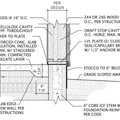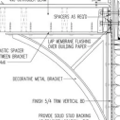Return water temperature and air-to-water heat pumps
Almost all the AWHP literature I see has only specs for COP VS supply water temp. This got me thinking how much difference RWT makes.
From an energy standpoint, that is still a fair bit of heat your are leaving in the liquid line. Vapor injection does take part of that heat back to the compressor, but that still seems like it costs energy as it has to be re-compressed. So it would make sense that lower RWT should improve COP.
Thinking more about it, why even vapor injection, why not a full regenerator setup like this:
https://www.maplesoft.com/applications/detail.aspx?id=154037
GBA Detail Library
A collection of one thousand construction details organized by climate and house part










Replies
So have two heat exchangers, one on the send side and one on the return side? The one on the return side takes water returning from the emitters at, say, 90F, and interacts with refrigerant coming off the evaporator at, say, outdoor temperature minus 20F?
You'd get an efficiency boost from the refrigerant being warmer, and the average temperature in the outbound heat exchanger being lower. Would that efficiency boost make up for the fact that you'd have to raise the temperature of the water by more?
It's an interesting idea.
This would be a refrigerant to refrigerant heat exchanger. Doesn't make sense on EVI, but on a non-evi unit, the liquid refrigerant coming out of the plate HX is near RWT. So there is still a lot of heat in it. This heat is pretty much lost when you go through the EEV as you are using part of the energy of the gas to cool it down.
By exchanging this heat before it gets to the EEV and transferring it to the refrigerant from the outdoor coil, you are now warming the gas up before it gets to the compressor, so it has to do less work to compress it.
I'm sure there is a catch. My feeling is the HX would be too big to be cost effective and EVI is cheaper.
So not really air-to-water specific, it could work for any heat pump.
This reminds me a lot of the discussion we had a few months ago about multi-stage dehumidifiers:
https://www.greenbuildingadvisor.com/question/using-a-heat-exchanger-to-increase-latent-heat-extraction
I seem to recall a dehumidifier that has two evaporator coils so it can cool the air in two stages. But I can't remember the name.
Messana makes a dehumidifier with a hydronic pre-cooling coil but still only a single evaporator and condenser coil.
Link? Or even product name?
link: https://messana.tech/downloads/user-manuals/ntd-user-manual/
page 10 has a flow diagram
Looking at the diagram more closely, the dehumidier actually has 2 condensers: an air cooled one (a secondary condenser that's used to return a neutral air temp) and a water cooled one (the main condenser)
“Almost all the AWHP literature I see has only specs for COP VS supply water temp. This got me thinking how much difference RWT makes.”
The way I see it all other things being equal the COP is mostly a function of the differential in the temp that the refrigerant evaporates and condenses. In the heat mode the two temps are dictated by the outdoor temp and units output supply temp. The refrigerant selected dictates a certain pressure for the two temps. The compressor must consume enough electricity to do the work of compressing that volume of gas from the low pressure to the high pressure.
The regenerator in this drawing is transferring some energy but it is tiny compared the energy transferred when the refrigerant changes state from gas to a liquid or vice versa. The only reason to build this machine is to make the states change.
My opinion the regenerator would not be helpful in a modern computer-controlled system. The computer is looking at point 6 in this drawing with the goal of making that temp be just slightly warmer than the boiling point of the refrigerant entering the compressor. This is the systems “super heat” The computer opens and closes the electronic expansion valve. The more super heat the less efficient the system is. If the super heat gets below 0° the liquid refrigerant could enter the compressor risking damaging the compressor.
Back to the question, the RWT is irrelevant so long as the flow volume is low enough that the unit can still create the required SWT. So lower RWT = lower flow volume because the unit is producing a fixed number of BTUs.
Walta
I have been messing with flow rates a bit to increase delta T and reduce RWT. Without proper instrumentation and logging, hard to say precisely, but I would say I can get a bit warmer water out of the unit at the same power. Since I'm temperature limited in my setup, that does make a difference in rad output.
@Walta. Most of the energy transfer does come from phase change but there is still not insignificant energy in the liquid refrigerant. This heat would normally be dumped in the evaporator so it is truly lost. Warming the gas also means a less power compressing up to target pressure, so it definitely does have an effect. I'm guessing the extra mass flow through the condenser with EVI also makes a difference and that is why it is the norm.
“I have been messing with flow rates a bit to increase delta T and reduce RWT. Without proper instrumentation and logging, hard to say precisely, but I would say I can get a bit warmer water out of the unit at the same power. Since I'm temperature limited in my setup, that does make a difference in rad output.”
My point is the number of BTUs moved is constant the greater the delt T the lower the volume of the flow.
Consider air conditioners have been a commercial product for 123 years now maybe half a million different engineers have spent their careers in laboratories building every possible experiment and configuration. If such a simple idea was even marginally beneficial it would undoubtedly have been widely adopted and become a normal part of every unit sold long ago.
Walta
If the number of BTU's is constant, then lowering the RWT will lower the SWT. The volume/mass flow rate will be unchanged unless an active control system is used to maintain the SWT.
Akos, AFAICT the reason EVI or a recuperator is used is cost. At large industrial scale, the recuperator is typically more cost effective. At small residential scale, EVI is more cost effective because the material cost of the heat exchanger is more than the controls for EVI.